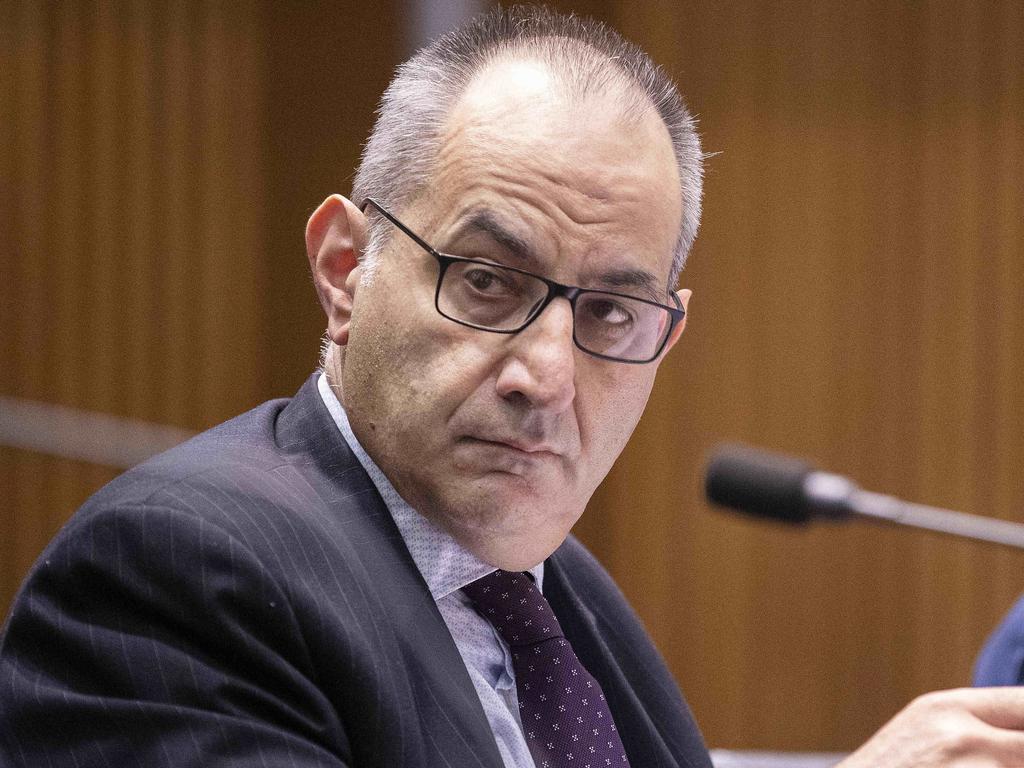Former Home Affairs boss Mike Pezzullo calls for ‘War Book’ in case of regional conflict
Australia needs to urgently develop a modern day ‘War Book’ for the nation’s preparedness in the event of an Indo-Pacific conflict, former Home Affairs boss Mike Pezzullo says.

Australia needs to urgently develop a modern day ‘War Book’ for the nation’s civil defence preparedness in the event that a potential war in the Indo-Pacific would increase the likelihood of the country coming under attack, former Home Affairs boss Mike Pezzullo has warned.
In a closed room speech to the strategic and defence think-tank, the Williams Foundation, Mr Pezzullo last week said he believed there was now a 10 per cent chance of military conflict in the region before 2030.
“We face, before 2030, the credible prospect of having to defend Australia during a major war in the Indo Pacific,” Mr Pezzullo said in a speech obtained by The Australian.
“Australian defence planning has since the Second World War rarely focused on the idea of mounting such a defence.
“Planning until the mid-1970s typically contemplated instead ‘forward defence’ – sending Australian military forces forward into Southeast Asia.
“Today, we need to contemplate Australia, and the airspace, seas and islands that surround us, as potentially constituting a theatre in a larger Indo Pacific war.
“For the sake of discussion, and planning, it would be prudent to rate the chance of war breaking out in the Indo-Pacific in the 2020s at ten per cent, at a minimum.”
But Australia was lacking a pandemic style civil preparedness and national mobilisation plan as part of a broader defence strategy, he said.
Mr Pezzullo was forced to stand down from his job last November for breaching the public sector code over a series of leaked messages in which he criticised former Coalition ministers.
It is understood Mr Pezzullo had been working on lessons from the pandemic on how modern day civilian mobilisation could be galvanised for a potential defence footing in response to a regional war, with significantly more complex strategies needed.
The last War Book that sought to address civil readiness was developed in 1957 under the Menzies government in response to the Cold War and the threat of a nuclear exchange between the US and the Soviet Union.
In the first public speaking role since being removed from the top job, the former Home Affairs secretary said a War Book would bring together the public and private sector to manage the civilian response to a war.
This would include the protection of critical infrastructure, cyber defence, mobilisation of the workforce and industry to cover supply chains, industrial materials, chemicals and minerals.
“In war, the most important question is whether the nation at large has the structures, capabilities and, above all, the mindset and national will that are required to fight and keep fighting; and to absorb, recover, endure, and prevail.

“These cannot be put in place or engendered on the eve of the storm.
He said sectoral plans would also address the “allocation, rationing, and/or stockpiling of fuel, energy, water, food, transport, shipping, aviation, communications, health services and pharmaceuticals, building and construction resources, and so on”.
“There would be plans for the protection of the civilian population (covering evacuation, fortification and/or shelter construction); for augmenting police, fire, rescue and ambulance capacities; and dealing with social cohesion, domestic security and public safety,” Mr Pezzullo, who was also the author of the 2009 defence white paper during the Rudd government, said.
“With the exception of brief periods during the Cold War, civil defence and national mobilisation have not been priorities for Australia since the Second World War because wars, such as were being fought, were remote from Australia, and not directly threatening to our population or territory.
“Today, war could come to our home, and potentially for an extended period.
“As a practical suggestion to focus effort, we should modernise the practice from the 1930s and the 1950s of the preparation of a ‘War Book’.

“War Books were guides on what would need to be done, and by whom, in the event of war. Preparing a modern War Book would help to focus the national mind, break down the abstraction of ‘war’ into its particulars, enhance preparedness, and contribute to resilience.
“A War Book would be prepared by the commonwealth, with contributions from the states and territories.
“As our society is today more dependent on private companies to operate critical infrastructure and deliver essential services, business would have to be deeply involved from the outset.
“Unlike earlier iterations, which were controlled by the Department of Defence, a modern War Book would be best prepared jointly by Defence and the Department of Home Affairs, the latter as a consequence of the crucial role that would be played by critical infrastructure providers, cybersecurity firms and emergency management bodies in any war effort.
“Other departments and agencies would be brought into the process, which Home Affairs could co-ordinate, as it did during the pandemic.”
Mr Pezzullo courted controversy in 2021 when the Labor opposition accused him of beating the drums of war over an Anzac Day speech he gave warning about the prospect of war in the region.
Defence Minister Richard Marles this week warned that a 10-year window of warning was now gone and the likelihood of conflict in the region had increased even in the past year.
In his lecture to the Williams Foundation conference on April 11, Mr Pezzullo said a War Book would deal with the entire span of civil defence and national mobilisation which would be required to move to a war footing, consisting of a range of co-ordinated plans.
“Lessons could be adapted from international experience (especially Ukraine and Israel), as well as domestic experiences, such as natural disasters and the Covid pandemic, noting however that war is different insofar as in war a conscious adversary calibrates and adjusts their actions as the situation unfolds.

“War is not simply another hazard in the ‘all hazards’ universe of emergency management. It has its own character and logic. We need to think about war as a national crisis unlike any other.
“Defence of the Australian theatre would be a higher priority than sending our forces forward, except for perhaps some on a limited scale, and would represent our principal contribution to the war effort.
“This would also be central to the adversary’s calculations about whether, when and where to strike us, and how heavily.
“This would have implications for the ADF’s force structure and how we might employ it operationally – with the priority being to develop an integrated and focused force, which was optimised for a campaign on and around our territory, and in the broader airspace, seas and islands of a theatre-wide area of operations.
“Civil defence and national mobilisation would be intrinsic to any war effort.
“If the possibility of war in the Indo Pacific is to be taken seriously, relevant preparations should be made urgently, but also proportionately and soberly.”








To join the conversation, please log in. Don't have an account? Register
Join the conversation, you are commenting as Logout